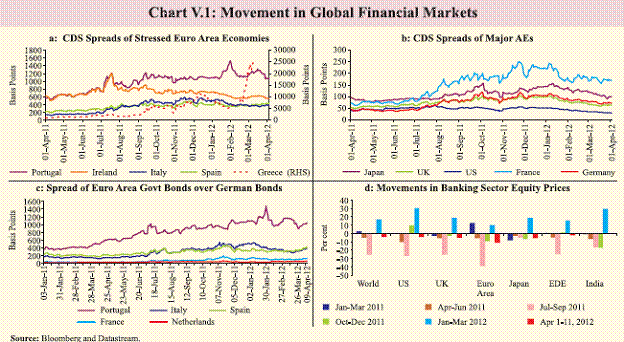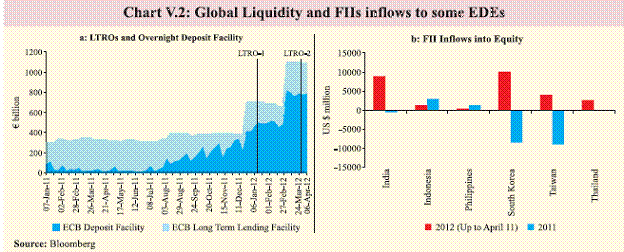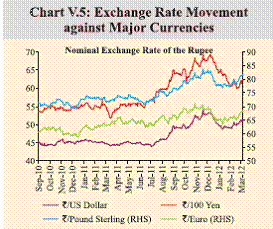V. Financial Markets - ಆರ್ಬಿಐ - Reserve Bank of India
V. Financial Markets
Global market sentiments have improved following policy interventions in the euro area and positive data from the US. Risks to EDEs capital flows from the deleveraging by European banks, although still prevalent, appear to have moderated in the wake of the ECB’s initiatives to extend liquidity support. Taking cues from favourable international developments, Indian financial markets revived in Q4 of 2011-12. The revival, however, has been primarily liquidity driven and expectations led. For the recovery to be sustained, macroeconomic fundamentals need to improve. Stress in euro area eases, but firewalls remain weak V.1 The imminent risks of a region-wide spread of contagion from the adverse feedback loop between the banks’ balance sheet and sovereign debt in the euro area that conditioned the global markets in Q3 of 2011-12 somewhat waned in the following quarter. Though risks from falling growth and high unemployment in parts of the euro area remain, funding pressures of the euro area banks have eased for the time being. This follows the European Central Bank (ECB)’s actions to infuse liquidity coupled with the individual sovereigns’ policy initiatives. Under the long-term refinancing operations (LTRO) of the ECB in December 2011 and February 2012, around €1 trillion has been injected. V.2 Yet another major development in the region has been the completion of the sovereign bond swap in Greece, amounting to €177 billion of debt, aimed at reducing the debt burden and financial stress. The agreement on a second bailout for Greece valued at €130 billion (which is backed by €28 billion contribution from the IMF) has also helped in improving global market sentiments. V.3 Some revival in the euro area term money markets and interbank activity was seen, indicating that the pressure on euro area banks may have temporarily eased. Market perception of falling sovereign credit risk is evident from the decline in sovereign spreads and improved equity market performance (Chart V.1).
V.4 Notwithstanding the reduction in financial market stress, euro area firewalls remain weak. Euro area member states have agreed to increase the size of the firewall to about € 800 billion (US$ 1 trillion). As a result, concerns about the adequacy of the firewall may have somewhat eased. However, in view of the mild recession the euro area is currently experiencing, widespread austerity measures could have implications for economic growth and tax revenue. Although the LTROs have pumped in a large amount of liquidity in the euro area banking system, a large part of this liquidity is finding its way to the overnight deposit facility of the ECB (Chart V.2a).Therefore, the amount of onward transmission of credit remains to be seen. It is possible that in search of yields a part of this liquidity is being channeled into emergining and developing economies’(EDEs) equity markets. Consequently, FII inflows into equity markets of EDEs have increased in 2012 so far (Chart V.2b). Ongoing easy monetary policy in AEs possibly enhances capital inflows to EDEs V.5 Elsewhere in the advanced economies (AEs), central banks continue with easy monetary policies that enhance global liquidity. The Bank of England decided to purchase an additional £50 billion worth of government securities, while the Bank of Japan announced an increase in its asset purchase programme. The Fed, aside from continuing with its policy stance of excessively low interest rates, observed that the majority of the large US banks display robust health in the face of conservative stress tests, and are capable of meeting the requisite capital adequacy norms even under adverse conditions. All these factors coupled with better than expected recovery in the US growth have temporarily helped reduce the stress in global financial markets and could have channeled FII flows into EDEs in search of higher yields. Pressures ease in domestic markets, but some volatility persists V.6 Despite the slowdown in domestic growth and the recent oil price increase, Indian equity markets stayed upbeat in Q4 of 2011-12, conditioned by the revival in global markets, the surge in FII inflows and the decline in domestic inflation. Reflecting the prevailing structural liquidity deficit coupled with outflows for advance tax payment by companies, money market rates remained elevated. The yields on government bonds fell for most part of the quarter, although the trend reversed following the budget announcements of higher borrowing in 2012-13. Policy measures taken by the Reserve Bank have reduced volatility in the currency markets.
Money market rates remained elevated reflecting deficit liquidity conditions V.7 In view of the tight liquidity conditions in the system, call rate remained at levels above the policy (repo) rate during H2 of 2011-12 (Chart V.3). Following the CRR cut in January 2012, the call rate that had risen to 9.0 percent in December 2011 declined slightly. However, it again moved up in March 2012 following tight liquidity conditions on account of quarterly advance tax payments. The rates in the collateralised segments (i.e., CBLO and market repo) moved in tandem with call rate, albeit at a lower level, during Q4. The prevailing deficit liquidity conditions prompted a few banks to access funds from the MSF window.
V.8 During 2011-12, while the share of call money in total overnight money market volume increased, that of collateralised segments declined. In the collateralised segment, banks and primary dealers remained the major groups of borrowers, and mutual funds (MFs) dominated as lenders (Table V.1). V.9 The weighted average effective interest rates (WAEIR) on certificates of deposits (CDs) firmed up during Q4 of 2011-12. The increase was significant towards the end of February 2012, due to tight liquidity conditions and lower rollover of CDs by MFs. V.10 In the primary g-sec market, the yields on auction Treasury Bills (TBs) generally firmed up till March 2012 in line with the large issuance and tight liquidity conditions. Yields harden following the announcement of higher government borrowing programme V.11 In the secondary market, the g-sec yield declined initially and was range-bound for most of Q4 reflecting improved sentiment on account of the OMO purchases by the Reserve Bank, an increase in the ceiling for investment in government securities by foreign institutional investors (FIIs) and expectation of moderation in inflation. The divergent trend in yield movements of TBs and dated securities resulted in an inverted yield curve during the period. This largely reflected the large issuances of TBs at the short-end of the yield curve. Following the Union Budget announcement of a higher than anticipated market borrowing programme and the subsequent issuance of auction calendar for dated securities, the 10 year yield rose steadily to 8.63 percent by March 30, 2012 as compared to 8.54 percent as on December 30, 2011 (Chart V.4).
V.12 According to SEBI data, FIIs made investment in debt worth `189.3 billion in Q4 of 2011-12. MFs also bought debt worth `1317.8 billion during the same period. V.13 The gross market borrowing programme of the central government through dated securities during 2011-12 to the tune of `5,100 billion, a 16.7 percent hike over the previous year, was successfully completed. The bid-cover ratio stood in the range of 1.39-5.12 as against 1.39-3.87 during the previous year. The cash balance of the central government transited into surplus from WMA/OD since February 7, 2012. V.14 During 2011-12, 24 states and the UT of Puducherry raised `1,586 billion on a gross basis which was almost 52 percent higher than that during the previous year. The weighted average yield firmed up to 8.79 percent from 8.39 percent during the previous year. Base rate remains sticky reflecting higher cost of funds V.15 During Q4 of 2011-12, deposit rates of SCBs remained mostly unchanged from their peak levels attained in H1 of 2011-12. Lending rates marginally notched up and seem to have plateaued in H2 of 2011-12 in line with the peaking of the policy rate cycle. Despite tight liquidity conditions, successive policy rate hikes and high cost of funds for banks, the base rate remained sticky on account of the slow down in non-food credit growth during H2 of 2011-12 (Table V.2).
Rupee stays volatile on CAD concerns and global uncertainty V.16 The policy measures undertaken to improve capital inflows have generally yielded the intended results, thereby enabling smoother financing of higher CAD. This, in turn, has led to the movement of the exchange rate in a narrow range from the last week of January 2012. The rupee moved up to 51.4 per US dollar as on April 13, 2012 from a low of 54.2 per US dollar recorded on December 15, 2011 (Chart V.5). V.17 A notable aspect of capital flows was that both debt and equity flows improved during Q4 led by policy measures, global liquidity conditions and investor perception. However, rising crude oil prices due to geo-political factors, and increased dollar demand led to a moderate depreciation of rupee since the first week of March 2012. Secondary equity markets improve with renewed FII inflows V.18 The Indian equity market saw a strong pick up in Q4 on the back of renewed FII support, a fall in inflation and firm trends in the global equity markets (Chart V.6). This recovery was broad-based, with all major sectoral indices moving up in line with the Sensex. According to SEBI data, FIIs bought shares worth `453.4 billion in Q4 of 2011-12; on the other hand, MFs sold shares worth ` 54.4 billion. FIIs have been the major contributors to the rally, presumably on account of higher global liquidity driven by the easy monetary policy pursued by AEs, the ECB’s long term lending programme and increase in the size of asset purchase programme by some AE central banks. However, in April 2012 so far (up to April 11) the Indian equity market declined in line with global markets.
The primary markets show incipient signs of recovery V.19 Almost dormant in Q3, the primary market witnessed a few issuances in the equity segment in Q4, indicating a slow recovery on the backdrop of the equity indices recovering from lower levels. However, the primary market sentiment still remains cautious on account of lower risk appetite of investors in the primary market following the negative returns on initial public offers (IPOs) during previous quarters (Chart V.7). On the supply side, corporates too abstained from the primary market for resource mobilisation due to the uncertain macroeconomic environment and investor sentiments (Table V.3).
V.20 Certain policy announcements in the Union Budget 2012-13 may help to revive the primary market. These include simplification in the issuance process of IPOs and the introduction of the Rajiv Gandhi Equity Savings Scheme. According to SEBI data, private placement increased to `2.4 trillion during 2011-12 (up to February) from `2.0 trillion during the corresponding period of the previous year. Housing price increases remain contained V.21 The Reserve Bank’s quarterly House Price Index (HPI), based on official data on property transaction from 9 cities, indicates that during Q3 of 2011-12, house price increased for all cities, barring Kolkata on an annual basis. However, price increases moderated in Mumbai, Jaipur and Kanpur (Chart V.8). The number of transactions on an annual basis declined in Mumbai, Bengaluru and Kanpur, while the y-o-y increase moderated in Ahmedabad and Jaipur.
Risks of disruptive movements in financial markets remain from euro area and financialisation of commodities V.22 Notwithstanding the signs of stabilisation over the past quarter, risks that stress in financial markets could return in 2012-13 remain.The focus has shifted to Spain, which faces high borrowing cost due to the burgeoning budget deficit. Recession looms large in Spain and this also raises concerns about possible contagion. Debt sustainability of Portugal and Greece remain fragile. The adequacy of the lending capacity of the European Financial Stability Facility (EFSF) is uncertain, given the size of debt of Italy and Spain.
V.23 The recent surge in crude oil prices due to geo-political tensions has emerged as a new risk factor to global and domestic financial markets. Volatile oil trades can occur in coming months given the uncertainty about the ongoing political initiatives. Furthermore, the EU sanctions on Iran may kick in only from July 2012. The financialisation of commodity markets has been considerable and with daily trading volumes of over US$ 1 trillion in oil markets alone, the uncertainty about oil price movement in 2012-13 remains. While as a baseline, global oil prices in 2012-13 could average around current levels, the upside risks are greater than the downside risks due to tighter inventory levels and lower spare capacities, which could result in supply shortages (Chart V.9). Should these upside risks materialise, the negative spillovers on Indian markets could be large given their impact on India’s inflation and with lag on growth, as also its fiscal and external sector positions. V.24 In March 2012, both the US Energy Information Agency (EIA) and OPEC revised their 2012 oil demand projections downwards. While the spike in oil prices largely reflected concerns about supply disruption from Iran and the Strait of Hormuz through which 20 percent of global oil supplies (about 17 million barrels) pass each day, price movements in 2012-13 could continue to be impacted by the July event. If the geo-political tensions recede, high crude oil prices may not be sustained, given the weak global growth outlook. Sustained high oil prices could themselves dampen the already weak global growth outlook. Nonetheless tight supply-demand conditions, alongside the presence of large liquidity in the global economy leave the commodity price outlook highly uncertain. |
|||||||||||||||||||||||||||||||||||||||||||||||||||||||||||||||||||||||||||||||||||||||||||||||||||||||||||||||||||||||||||||||||||||||||||||||||||||||||||||||||||||||
































